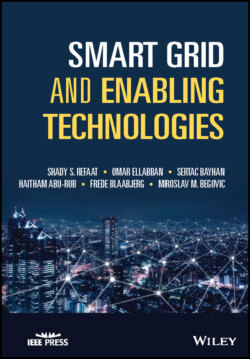Читать книгу Smart Grid and Enabling Technologies - Frede Blaabjerg - Страница 32
1.5.4.2 Power Line Communication (PLC)
ОглавлениеPLC permits data exchange among devices by electrical power lines. PLC is employed by including a modulated carrier signal to power cables. The benefit of the PLC is the currently recognized infrastructure that decreases deployment costs. Drawbacks include the existence of higher harmonics in the power lines that interfere with communication signals and the limited frequency of communication. Installing a number of smart meters and communication infrastructure should be implemented according to certain standards that are acknowledged by all companies and utilities taking part in building the SG. Different organizations are working on SG standardization such as the European Committee for Standardization, American National Standards Institute (ANSI), International Telecommunication Union (ITU), Institute of Electrical and Electronics Engineers (IEEE), and others. The well‐known standards for SG communications are IEEE P2030, which provides guidelines for interoperability of the electric power system with end‐use applications and loads; IEEE P1901 used by all classes of Broadband over Power Line (BPL) devices, entailing devices utilized for the connection to internet access services and devices utilized in buildings for LANs, smart energy applications, transportation platforms (vehicle), and other data distribution applications; IEC62351, which deals with cybersecurity issues of the SG; IEC62056 for electricity metering data exchange; PLC G3 to allow data and control messages to be transferred to generation, transmission, and distribution systems. There are more standards for SG communication including 802.15.4, ISO 1802, IPv4, DNP3, IEC61970, etc. [34]. More details on the standardization will be discussed in Chapter 17.
